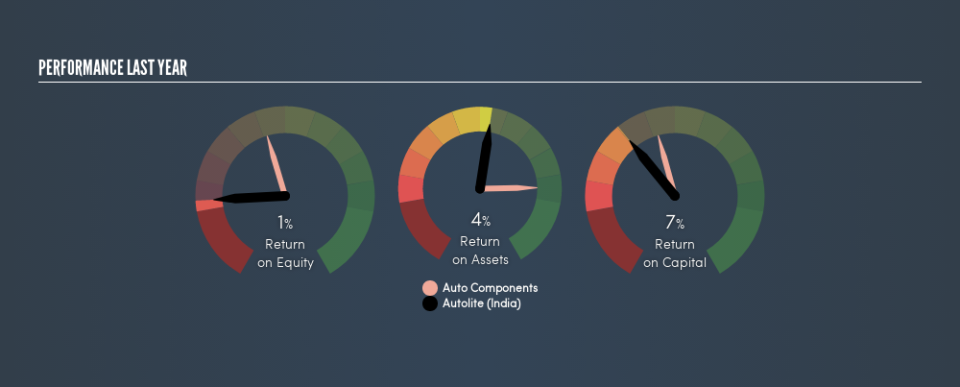Why We’re Not Impressed By Autolite (India) Limited’s (NSE:AUTOLITIND) 7.3% ROCE

Today we are going to look at Autolite (India) Limited (NSE:AUTOLITIND) to see whether it might be an attractive investment prospect. To be precise, we'll consider its Return On Capital Employed (ROCE), as that will inform our view of the quality of the business.
First, we'll go over how we calculate ROCE. Second, we'll look at its ROCE compared to similar companies. Then we'll determine how its current liabilities are affecting its ROCE.
Understanding Return On Capital Employed (ROCE)
ROCE is a measure of a company's yearly pre-tax profit (its return), relative to the capital employed in the business. All else being equal, a better business will have a higher ROCE. Ultimately, it is a useful but imperfect metric. Author Edwin Whiting says to be careful when comparing the ROCE of different businesses, since 'No two businesses are exactly alike.'
How Do You Calculate Return On Capital Employed?
Analysts use this formula to calculate return on capital employed:
Return on Capital Employed = Earnings Before Interest and Tax (EBIT) ÷ (Total Assets - Current Liabilities)
Or for Autolite (India):
0.073 = ₹44m ÷ (₹1.1b - ₹502m) (Based on the trailing twelve months to March 2018.)
Therefore, Autolite (India) has an ROCE of 7.3%.
See our latest analysis for Autolite (India)
Does Autolite (India) Have A Good ROCE?
ROCE can be useful when making comparisons, such as between similar companies. Using our data, Autolite (India)'s ROCE appears to be significantly below the 16% average in the Auto Components industry. This performance is not ideal, as it suggests the company may not be deploying its capital as effectively as some competitors. Regardless of how Autolite (India) stacks up against its industry, its ROCE in absolute terms is quite low (especially compared to a bank account). There are potentially more appealing investments elsewhere.
Autolite (India)'s current ROCE of 7.3% is lower than 3 years ago, when the company reported a 10% ROCE. So investors might consider if it has had issues recently.
When considering this metric, keep in mind that it is backwards looking, and not necessarily predictive. ROCE can be misleading for companies in cyclical industries, with returns looking impressive during the boom times, but very weak during the busts. ROCE is only a point-in-time measure. You can check if Autolite (India) has cyclical profits by looking at this free graph of past earnings, revenue and cash flow.
Autolite (India)'s Current Liabilities And Their Impact On Its ROCE
Current liabilities include invoices, such as supplier payments, short-term debt, or a tax bill, that need to be paid within 12 months. Due to the way the ROCE equation works, having large bills due in the near term can make it look as though a company has less capital employed, and thus a higher ROCE than usual. To counter this, investors can check if a company has high current liabilities relative to total assets.
Autolite (India) has total assets of ₹1.1b and current liabilities of ₹502m. Therefore its current liabilities are equivalent to approximately 46% of its total assets. Autolite (India) has a medium level of current liabilities (boosting the ROCE somewhat), and a low ROCE.
What We Can Learn From Autolite (India)'s ROCE
There are likely better investments out there. But note: make sure you look for a great company, not just the first idea you come across. So take a peek at this free list of interesting companies with strong recent earnings growth (and a P/E ratio below 20).
I will like Autolite (India) better if I see some big insider buys. While we wait, check out this free list of growing companies with considerable, recent, insider buying.
We aim to bring you long-term focused research analysis driven by fundamental data. Note that our analysis may not factor in the latest price-sensitive company announcements or qualitative material.
If you spot an error that warrants correction, please contact the editor at editorial-team@simplywallst.com. This article by Simply Wall St is general in nature. It does not constitute a recommendation to buy or sell any stock, and does not take account of your objectives, or your financial situation. Simply Wall St has no position in the stocks mentioned. Thank you for reading.

